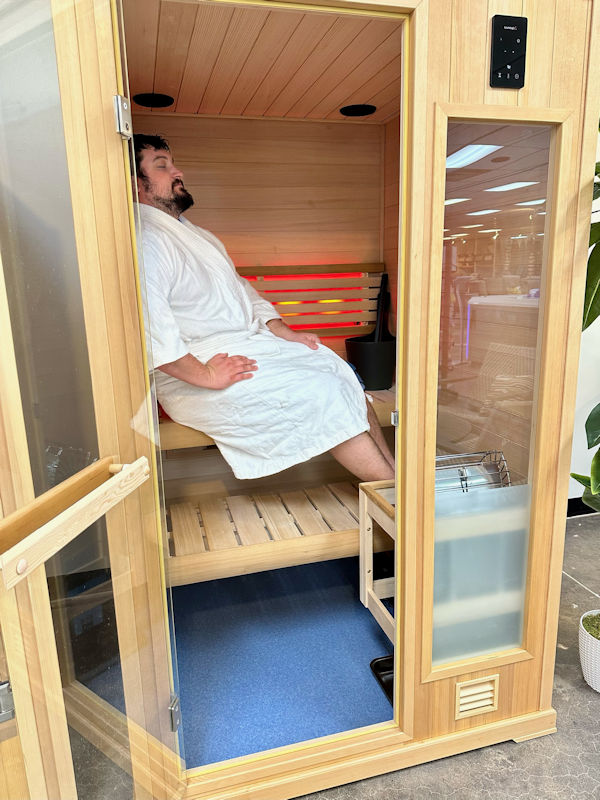Decoding the Infrared and Traditional Sauna
What is your goal for sauna bathing? Wondering how to choose which one is right for you? Let’s get to work decoding the Finnleo infrared and traditional sauna. We’ve even got a hybrid model that combines the best of both!
It is worth noting that we aren’t going to decide which is better. We’re simply going to look at the differences so you can choose the model that is best for you.
Comparing the Similarities
First, let’s look at how they are similar and their unique benefits. People have many goals with sauna bathing, but generally that includes:
- Relaxation
- Stress reduction
- Sweating (for detoxification)
- Getting rid of body aches and pains
Both the traditional and infrared saunas take care of this for you. The way they do it is different, though.
The ancient Greek philosopher Parmenides suggested: “Give me the power to produce fever, and I’ll cure all disease.” You may know that the presence of a fever plays a role in curing an infection. The same principle applies to the healing power of increasing your body temperature in a sauna.
Both types are dry.
The infrared sauna is close to the normal level of humidity of your house unless it’s been on for a long time. The traditional sauna is drier at about 10% or lower. This is just until you sprinkle water on the rocks, though. With the traditional sauna, you control the temperature and the humidity by how much water you add to the rocks. In an infrared sauna, you control the temperature, but the humidity simply is what it is.
The effects are the same.
While you bathe and sweat in either type of sauna, you find you are deeply relaxed, and your sore muscles and aching joints feel better. As you perspire, you burn some calories.

Comparing the Differences
While there are definitive facts that separate them, there are also some anecdotal ones. Here are the factual differences between the two types of saunas.
- Heating method
- Temperature
- Amount of energy used
- Heat up time
- The experience
Now, let’s break those down.
Heating Method
In a traditional sauna, you perspire when you enter. If you properly heat the sauna, the walls are warm, the rocks are heated, and the air temp is right where you want it. The heat literally envelopes you.
An electric heater heats the stones, which radiates heat throughout the sauna. Many traditional sauna bathers enjoy the process of pouring water over the rocks to raise the humidity levels. Doing this makes the room more comfortable, moistens your nasal passages (great if you have a cold!), and allows you to add essential oils for an aromatherapy experience.
In an infrared sauna, the heat waves raise your body temperature. To get to this increased temperature, infrared emitters create infrared energy.
The infrared energy deeply penetrates your skin and warms your muscles and joints. When the energy enters the body, it causes the body temperature to increase and ultimately results in perspiration. To get the most benefit, you want to sit in front of the infrared emitters.

This is Ryan our Construction Superintendent enjoy the Finnleo Hallmark 44.
The Temperature
- The temperature for a traditional sauna typically ranges between 150 and 185º F. In the United States, the Underwriters Laboratory (UL) dictates that the maximum temperature at the ceiling level is 194º F (90º C). So, the hottest point in the sauna (at the ceiling directly above the sauna heater) is typically between 185 and 190º F.
- The temperature for a far-infrared sauna is usually set between 120 and 140º F. It is worth noting that the goal of an infrared sauna is not to achieve a high temperature. Instead, you want the emitters to remain active because infrared energy is only being emitted (therefore providing the benefit of the deep penetrating infrared heat) when the emitters are on. So, the temperature difference here doesn’t really matter since you profusely sweat in both scenarios. The only difference is the heating method. You sweat the same but at a lower temperature.
The Heat-Up Time
- For a traditional sauna, you want to leave 30-40 minutes for the sauna to reach your desired temperature and to properly pre-heat the rocks.
- For an infrared room, you can start bathing when you turn the sauna on since the infrared energy is being emitted by the heaters. You may want to wait, though, until the room is 110º F or hotter.
The Length of Use
It’s recommended that sauna bathers soak for about 10-15 minutes per session, and this is the same for both sauna types. You can spend a bit longer (20-30 minutes) in an infrared sauna, though.
It is important while bathing to monitor how you feel. Make sure you drink enough water and don’t soak too long.
Amount of Energy You Use
For many of our customers, energy use matters. While neither the traditional nor infrared sauna will increase your electric bill drastically, there is a difference in their energy usage.
If we compare a two-person sauna, the traditional sauna will cost you about 50 cents to run for an hour. For an infrared sauna, you can expect the cost of a two-person sauna to run you about 18 cents an hour.
The Overall Experience
There is a social component to sauna bathing. While you can certainly do it on your own, for centuries the sauna has been a social gathering place. The sauna is perfect for family time, deep conversations, and simply time spent together.
Traditional saunas are generally larger, so this is done more easily here. While you can spend time together in an infrared sauna, they usually lend themselves to small groups.
Final Thoughts on Infrared and Traditional Saunas
At Ultra Modern Pool and Patio, we are here to help you make your decision about an infrared or traditional sauna. Either way, the health benefits are immense, and you will improve your overall wellness.
And, as we say often, “The sauna you’ll love is the sauna you use!”
In addition, if you like both types of Finnleo saunas, we do offer a hybrid option. Stop by or contact us today to learn more!



